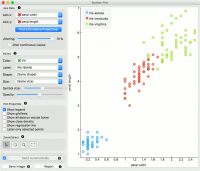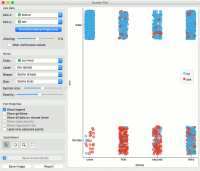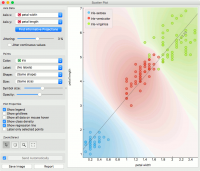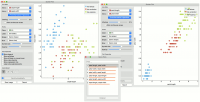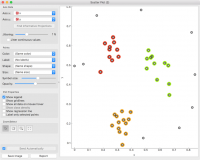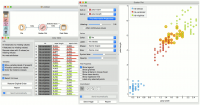Orange: Scatter Plot
Sumber: https://docs.biolab.si//3/visual-programming/widgets/visualize/scatterplot.html
Visualisasi Scatter plot dengan analisis eksploratif dan peningkatan visualisasi data yang pandai.
Input
Data: input dataset Data Subset: subset of instances Features: list of attributes
Output
Selected Data: instances selected from the plot Data: data with an additional column showing whether a point is selected
Scatter Plot widget menyediakan visualisasi scatter plot 2 dimensi untuk atribut yang kontinu dan bernilai diskrit. Data ditampilkan sebagai kumpulan titik, masing-masing memiliki nilai atribut sumbu x menentukan posisi pada sumbu horizontal dan nilai atribut sumbu y menentukan posisi pada sumbu vertikal. Berbagai properti grafik, seperti warna, ukuran dan bentuk titik, judul sumbu, ukuran titik maksimum, dan jittering dapat disesuaikan di sisi kiri widget. Snapshot di bawah ini menunjukkan scatter plot dataset Iris dengan matching warna atribut class.
- Select the x and y attribute. Optimize your projection by using Rank Projections. This feature scores attribute pairs by average classification accuracy and returns the top scoring pair with a simultaneous visualization update. Set jittering to prevent the dots overlapping. If Jitter continuous values is ticked, continuous instances will be dispersed.
- Set the color of the displayed points (you will get colors for discrete values and grey-scale points for continuous). Set label, shape and size to differentiate between points. Set symbol size and opacity for all data points. Set the desired colors scale.
- Adjust plot properties:
- Show legend displays a legend on the right. Click and drag the legend to move it.
- Show gridlines displays the grid behind the plot.
- Show all data on mouse hover enables information bubbles if the cursor is placed on a dot.
- Show class density colors the graph by class (see the screenshot below).
- Show regression line draws the regression line for pair of continuous attributes.
- Label only selected points allows you to select individual data instances and label them.
- Select, zoom, pan and zoom to fit are the options for exploring the graph. The manual selection of data instances works as an angular/square selection tool. Double click to move the projection. Scroll in or out for zoom.
- If Send automatically is ticked, changes are communicated automatically. Alternatively, press Send.
- Save Image saves the created image to your computer in a .svg or .png format.
- Produce a report.
Untuk atribut diskrit, jittering menghindari tumpang tindih titik yang memiliki nilai yang sama untuk kedua sumbu, dan karenanya kepadatan titik di wilayah tersebut lebih sesuai dengan data. Sebagai contoh, scatter plot untuk dataset Titanic, melaporkan jenis kelamin penumpang dan kelas ditunjukkan di bawah ini; tanpa jittering, scatter plot hanya akan menampilkan delapan titik berbeda.
Berikut adalah contoh Scatter Plot widget jika Show class density dan Show regression line boxes di centang.
Intelligent Data Visualization
If a dataset has many attributes, it is impossible to manually scan through all the pairs to find interesting or useful scatter plots. Orange implements intelligent data visualization with the Find Informative Projections option in the widget.
If a categorical variable is selected in the Color section, the score is computed as follows. For each data instance, the method finds 10 nearest neighbors in the projected 2D space, that is, on the combination of attribute pairs. It then checks how many of them have the same color. The total score of the projection is then the average number of same-colored neighbors.
Computation for continuous colors is similar, except that the coefficient of determination is used for measuring the local homogeneity of the projection.
To use this method, go to the Find Informative Projections option in the widget, open the subwindow and press Start Evaluation. The feature will return a list of attribute pairs by average classification accuracy score.
Below, there is an example demonstrating the utility of ranking. The first scatter plot projection was set as the default sepal width to sepal length plot (we used the Iris dataset for simplicity). Upon running Find Informative Projections optimization, the scatter plot converted to a much better projection of petal width to petal length plot.
Selection
Selection can be used to manually defined subgroups in the data. Use Shift modifier when selecting data instances to put them into a new group. Shift + Ctrl (or Shift + Cmd on macOs) appends instances to the last group.
Signal data outputs a data table with an additional column that contains group indices.
Explorative Data Analysis
The Scatter Plot, as the rest of Orange widgets, supports zooming-in and out of part of the plot and a manual selection of data instances. These functions are available in the lower left corner of the widget.
The default tool is Select, which selects data instances within the chosen rectangular area. Pan enables you to move the scatter plot around the pane. With Zoom you can zoom in and out of the pane with a mouse scroll, while Reset zoom resets the visualization to its optimal size. An example of a simple schema, where we selected data instances from a rectangular region and sent them to the Data Table widget, is shown below. Notice that the scatterplot doesn’t show all 52 data instances, because some data instances overlap (they have the same values for both attributes used).
Example
The Scatter Plot can be combined with any widget that outputs a list of selected data instances. In the example below, we combine Tree and Scatter Plot to display instances taken from a chosen decision tree node (clicking on any node of the tree will send a set of selected data instances to the scatterplot and mark selected instances with filled symbols).
References
Gregor Leban and Blaz Zupan and Gaj Vidmar and Ivan Bratko (2006) VizRank: Data Visualization Guided by Machine Learning. Data Mining and Knowledge Discovery, 13 (2). pp. 119-136. Available here.
